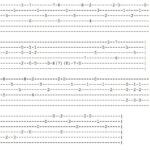Chords are fundamental to playing guitar. As a beginner, learning simple chords is one of the very first and most crucial steps. Understanding what a chord is opens up a world of musical possibilities on the guitar.
Defining a Guitar Chord: The Building Blocks of Music
In its most basic form, a guitar chord is created when you play three or more different musical notes simultaneously. That’s the essence of it. Even knowing just a handful of chords will allow you to play countless songs. Think about the famous saying attributed to country music legend Harlan Howard, who described country music as “three chords and the truth.” This simple concept highlights the power and versatility found even within basic chord structures.
As you progress with guitar, you’ll delve deeper into the language of chords. You’ll encounter more complex chord types with intricate names, and you’ll begin to grasp the theory behind how chords are constructed and named. While chords can become quite sophisticated, the core idea remains simple, especially when first starting on the guitar.
Chords, Intervals, and Triads: Key Distinctions
It’s important to remember that a chord requires at least three different notes played together.
If you play only two notes at the same time on your guitar, this is technically called an interval, not a chord. A chord, in fact, is defined as a group of specific intervals combined. So, playing an E and a B note together, while musically interesting, doesn’t constitute a chord by definition.
Similarly, playing the same note multiple times doesn’t create a chord. If you were to play three notes, but all of them were F#, that wouldn’t be considered a chord either. The crucial element is that the notes must be different and played at specific intervals relative to each other to form a chord.
Basic three-note chords are known as triads. The notes within these chords are related to each other in specific ways, governed by musical scales and principles of music theory. While this might sound complex, the fundamental idea is that the three notes in a triad harmonize together according to a defined musical formula.
Looking at common open guitar chords (chords that utilize open strings), you can see this triad principle in action even when strumming all six strings. Take a simple open G chord as an example (Fig. 1). You’ll notice it is constructed using only three distinct notes – G, B, and D, repeated in different octaves across the six strings. An open A chord (Fig. 2) similarly utilizes just three notes: A, E, and C#. And an open C chord (Fig. 3) is built from C, E, and G.
Fig 1: Diagram illustrating the finger placement for an open G major chord on the guitar, a fundamental chord for beginners.
Fig 2: Illustration of an open A major chord, demonstrating a common and essential chord shape for guitarists.
Fig 3: Visual representation of the open C major chord on the guitar fretboard, a basic chord in many songs.
To learn more about expanding your chord vocabulary, you can explore resources like Fender Play’s chord library, which offers a wealth of information on different chord types and techniques for mastering them.
If you’re ready to dive deeper, consider signing up for a free Fender Play trial!

